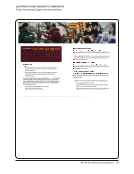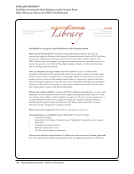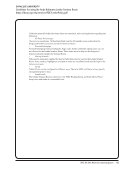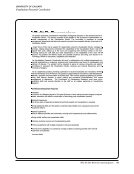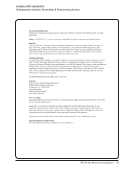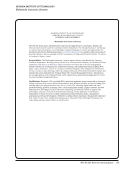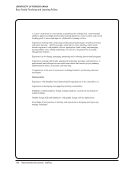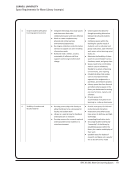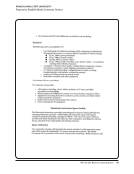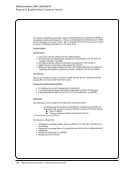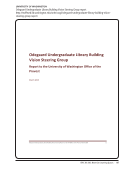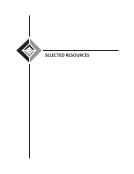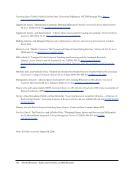SPEC Kit 342: Next-Gen Learning Spaces · 13
As we move well into the digital age, resources
that libraries are responsible for are defined now not
only as simple print collections, but also as a collec-
tion of services and programming. Librarians are
curators of collaboration, partners in specialized re-
search, and innovators in pedagogy and instruction.
How we organize and deliver these Next-Gen re-
sources will strongly influence the future of libraries
and librarianship.
Library Instruction
As learning spaces evolve and new programs develop,
accompanying instructional methods and educational
partnerships are growing rapidly. New pedagogies are
being developed for these innovative spaces. These
library learning spaces provide an appropriate venue
for testing new educational technologies as well.
At 68 of the responding libraries, the most com-
monly reported technologies in the classroom are
microphone and voice projection tools (85%), screen
sharing software (65%), document cameras (60%), re-
cording and broadcasting technologies (60%), click-
ers (57%), and SMART Boards (52%). Also mentioned
were mobile technologies, media:scape units, 3D
printers, video conferencing technology, and spe-
cialized software.
There are many types of library instruction most
respondents stated that classrooms with fixed tech-
nology are where most of their classes are held. Sixty-
four of the 70 responding libraries hold formal instruc-
tion in classrooms with fixed computers, 51 indicated
that traditional classrooms with no technology are
used for formal instruction, and 27 respondents in-
dicated they use event space for formal classes. The
survey data indicates that informal instruction takes
place mainly in open computer labs (30) or multime-
dia labs with specialized software (28). Open group
study spaces (20) and exhibit spaces (18) are also used
for informal instruction. In many cases, it appears that
respondents use spaces for a blend of both purposes.
Most of the 71 responding libraries indicated that
software training is the most commonly provided
walk-in instruction (49). Other frequent walk-in offer-
ings include research skills (46) and information lit-
eracy instruction (42). Less frequently offered are de-
sign principles (14) and design practice (8). This trend
is similar for the type and number of pre-registered
library classes.
Information literacy (68) and research skills (61)
were the most commonly reported course-integrat-
ed instruction, followed by software training (29).
Again, design principles (9) and practice (5) are not
offered widely.
In general, library for-credit classes are not offered
widely across the board, but for those libraries that
do, information literacy (17) and research skills (14)
are the most commonly offered, followed by presen-
tation skills (4).
Recognition of library class session completion is
not currently widespread. Survey results indicated
that the majority of respondents (55, or 77%) have
nothing in place that certifies class or series comple-
tion for the students. Of the 23% that do have some-
thing in place, in most cases this is a certificate of
some kind.
Instruction in libraries is primarily delivered by
librarians (69), archivists (55), and other library staff
(54). Campus partners also provide instruction at
46 libraries.
Instruction in libraries is growing and rapidly be-
coming a vehicle for collaboration and outreach with
library users. Instruction is one of the ways librar-
ies continue to stay relevant on academic campuses.
New instructional programs present opportunities to
experiment with the curriculum and new methods
of content delivery. Librarians are equal partners in
course development with campus and community.
The survey findings reflect how library instruction
is becoming more formalized librarians are find-
ing ways to go beyond one-shot optional classes and
offer a wide variety of instructional programs that
are packaged as a series, integrated into academic
courses, or tailored for specialized needs. Some li-
braries are finding ways to offer for-credit classes and
certificates. Although less commonly offered through
libraries at present, topics related to design principles
and practice is one of the newer concepts being ex-
plored. Traditionally, libraries have only stayed within
certain boundaries of instruction. However, these
findings show that library instruction includes not
only teaching users how to use virtual tools such as
databases and software, but also encouraging users to
As we move well into the digital age, resources
that libraries are responsible for are defined now not
only as simple print collections, but also as a collec-
tion of services and programming. Librarians are
curators of collaboration, partners in specialized re-
search, and innovators in pedagogy and instruction.
How we organize and deliver these Next-Gen re-
sources will strongly influence the future of libraries
and librarianship.
Library Instruction
As learning spaces evolve and new programs develop,
accompanying instructional methods and educational
partnerships are growing rapidly. New pedagogies are
being developed for these innovative spaces. These
library learning spaces provide an appropriate venue
for testing new educational technologies as well.
At 68 of the responding libraries, the most com-
monly reported technologies in the classroom are
microphone and voice projection tools (85%), screen
sharing software (65%), document cameras (60%), re-
cording and broadcasting technologies (60%), click-
ers (57%), and SMART Boards (52%). Also mentioned
were mobile technologies, media:scape units, 3D
printers, video conferencing technology, and spe-
cialized software.
There are many types of library instruction most
respondents stated that classrooms with fixed tech-
nology are where most of their classes are held. Sixty-
four of the 70 responding libraries hold formal instruc-
tion in classrooms with fixed computers, 51 indicated
that traditional classrooms with no technology are
used for formal instruction, and 27 respondents in-
dicated they use event space for formal classes. The
survey data indicates that informal instruction takes
place mainly in open computer labs (30) or multime-
dia labs with specialized software (28). Open group
study spaces (20) and exhibit spaces (18) are also used
for informal instruction. In many cases, it appears that
respondents use spaces for a blend of both purposes.
Most of the 71 responding libraries indicated that
software training is the most commonly provided
walk-in instruction (49). Other frequent walk-in offer-
ings include research skills (46) and information lit-
eracy instruction (42). Less frequently offered are de-
sign principles (14) and design practice (8). This trend
is similar for the type and number of pre-registered
library classes.
Information literacy (68) and research skills (61)
were the most commonly reported course-integrat-
ed instruction, followed by software training (29).
Again, design principles (9) and practice (5) are not
offered widely.
In general, library for-credit classes are not offered
widely across the board, but for those libraries that
do, information literacy (17) and research skills (14)
are the most commonly offered, followed by presen-
tation skills (4).
Recognition of library class session completion is
not currently widespread. Survey results indicated
that the majority of respondents (55, or 77%) have
nothing in place that certifies class or series comple-
tion for the students. Of the 23% that do have some-
thing in place, in most cases this is a certificate of
some kind.
Instruction in libraries is primarily delivered by
librarians (69), archivists (55), and other library staff
(54). Campus partners also provide instruction at
46 libraries.
Instruction in libraries is growing and rapidly be-
coming a vehicle for collaboration and outreach with
library users. Instruction is one of the ways librar-
ies continue to stay relevant on academic campuses.
New instructional programs present opportunities to
experiment with the curriculum and new methods
of content delivery. Librarians are equal partners in
course development with campus and community.
The survey findings reflect how library instruction
is becoming more formalized librarians are find-
ing ways to go beyond one-shot optional classes and
offer a wide variety of instructional programs that
are packaged as a series, integrated into academic
courses, or tailored for specialized needs. Some li-
braries are finding ways to offer for-credit classes and
certificates. Although less commonly offered through
libraries at present, topics related to design principles
and practice is one of the newer concepts being ex-
plored. Traditionally, libraries have only stayed within
certain boundaries of instruction. However, these
findings show that library instruction includes not
only teaching users how to use virtual tools such as
databases and software, but also encouraging users to









































































































































